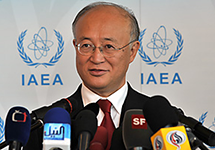Michelle Dover
June 9, 2014

IAEA Director, Yukiya Amano, Source: IAEA
Russia’s annexation of Crimea risks reopening an old debate within the International Atomic Energy Agency (IAEA) about whether some states can be subject to less intensive safeguards efforts than others. There are two nuclear facilities—a 200 kilowatt research reactor and a critical assembly—under IAEA safeguards at Sevastopol National University of Nuclear Energy and Industry, located in now Russian-controlled Crimea. These facilities are covered under Ukraine’s safeguards agreement with the IAEA. The Agency must decide whether it can still validate that all of Ukraine’s facilities are under effective safeguards, despite Ukraine’s inability to provide access to these sites. Russia and the IAEA do not have a full-scope safeguards agreement because Russia is a nuclear weapon state, so the legal means for the IAEA to conduct inspections at these facilities is now in question.
How the IAEA addresses this challenge is important. The IAEA has not yet adopted a formal position on the status of Crimea, emphasizing that it will continue to implement safeguards according to IAEA statute and international law. Given the sensitivities, the IAEA wants to avoid addressing this complex political problem as long as possible. Putting off a decision, however, has consequences for safeguards implementation in Ukraine.
Ukraine’s Broader Conclusion
Since 2010, the IAEA has granted Ukraine what is known as the “broader conclusion.” This is the IAEA’s highest rating that all nuclear material in the country is being used for exclusively peaceful purposes. This blanket conclusion can only be drawn when the state has both a full-scope safeguards agreement and the Additional Protocol in force, and has undergone further review by the IAEA. Once a country obtains the broader conclusion, the IAEA can reduce the frequency of its inspections and some of its timeliness goals because of its confidence in its ability to monitor all aspects of the state’s nuclear activities. This saves money and effort that can be spent elsewhere, a major issue for the cash-strapped agency. Ukraine has benefited from this practice—known as an integrated safeguards approach—since 2012.
The IAEA must now decide whether to revoke Ukraine’s broader conclusion and revert to its original inspection efforts because Ukraine can no longer provide access to all of its nuclear sites and continues to experience political unrest. Withdrawing the broader conclusion would cost the IAEA and Ukrainian regulators both time and money, and would be a blow to Ukraine’s nonproliferation status—all because of Russia’s illegal invasion and annexation of Crimea. One possible solution resides in paragraph 75(d) in Ukraine’s comprehensive safeguards agreement, which states that, in the case of “unusual circumstances requir[ing] extended limitations on access by the Agency” the state and the IAEA must “promptly make arrangements with a view to enabling the Agency to discharge its safeguards responsibilities.” This clause would allow the IAEA to continue to draw the broader conclusion in Ukraine. If the situation in eastern Ukraine continues to deteriorate, however, the IAEA will face serious questions about whether it can confidently affirm, with only less-intensive safeguards in place, that all nuclear material in the country is still confined to exclusively peaceful activities.
IAEA’s Next Move
These arcane legal details matter because Director General Yukiya Amano will have to report any agreement between the IAEA and Ukraine to the Agency’s governing body, the Board of Governors. Amano was able to delay such a decision when the board met in early June because there is no immediate need to conduct an inspection at either of the two facilities. But Amano has good reason to be wary—a report is likely to spark a vicious debate within the board, instigated either by Russia or by those states who see integrated safeguards as discrimination. In the past, several states have protested that the broader conclusion can be a way for the IAEA to reward political favorites, and have questioned whether the IAEA would ever revoke such a conclusion, no matter the circumstances. Member states are watching closely to see how the IAEA will implement integrated safeguards in states in turmoil, in no small part because integrated safeguards approaches were introduced only in 2001.
Despite this risk, the IAEA should withdraw Ukraine’s broader conclusion. This act would increase states’ confidence that the finding is the result of a technical analysis, not political decisions. Given the lack of access to certain facilities and ongoing instability, it is hard to believe the IAEA can continue to confidently draw such sweeping conclusions without major changes to how it implements safeguards. If it does not revoke the broader conclusion, the IAEA will need to provide the Board of Governors ample evidence to justify its decision. If the IAEA does withdraw the broader conclusion, it should lay out clear steps for how Ukraine can regain it, taking into account the new political reality. By creating a precedent for the conditions under which the broader conclusion can be revoked and reinstated, the IAEA would strengthen the technical and political credibility of the broader conclusion and integrated safeguards.
